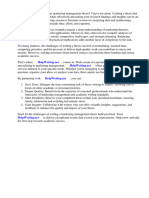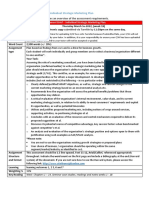0 ratings0% found this document useful (0 votes)
52 viewsIndividual Reflect
Individual Reflect
Uploaded by
Thị Thùy Trang LêThe document summarizes a research paper on business model innovation. It discusses the concept of business model innovation and its importance for companies facing uncertainty. It also identifies challenges to business model innovation, such as lack of understanding and resistance to change. The document recommends that companies develop a culture of innovation, create a clear vision, engage employees, and collaborate with partners to overcome these challenges and successfully implement business model innovation.
Copyright:
© All Rights Reserved
Available Formats
Download as PDF, TXT or read online from Scribd
Individual Reflect
Individual Reflect
Uploaded by
Thị Thùy Trang Lê0 ratings0% found this document useful (0 votes)
52 views4 pagesThe document summarizes a research paper on business model innovation. It discusses the concept of business model innovation and its importance for companies facing uncertainty. It also identifies challenges to business model innovation, such as lack of understanding and resistance to change. The document recommends that companies develop a culture of innovation, create a clear vision, engage employees, and collaborate with partners to overcome these challenges and successfully implement business model innovation.
Copyright
© © All Rights Reserved
Available Formats
PDF, TXT or read online from Scribd
Share this document
Did you find this document useful?
Is this content inappropriate?
The document summarizes a research paper on business model innovation. It discusses the concept of business model innovation and its importance for companies facing uncertainty. It also identifies challenges to business model innovation, such as lack of understanding and resistance to change. The document recommends that companies develop a culture of innovation, create a clear vision, engage employees, and collaborate with partners to overcome these challenges and successfully implement business model innovation.
Copyright:
© All Rights Reserved
Available Formats
Download as PDF, TXT or read online from Scribd
Download as pdf or txt
0 ratings0% found this document useful (0 votes)
52 views4 pagesIndividual Reflect
Individual Reflect
Uploaded by
Thị Thùy Trang LêThe document summarizes a research paper on business model innovation. It discusses the concept of business model innovation and its importance for companies facing uncertainty. It also identifies challenges to business model innovation, such as lack of understanding and resistance to change. The document recommends that companies develop a culture of innovation, create a clear vision, engage employees, and collaborate with partners to overcome these challenges and successfully implement business model innovation.
Copyright:
© All Rights Reserved
Available Formats
Download as PDF, TXT or read online from Scribd
Download as pdf or txt
You are on page 1of 4
Tên, logo, môn,.....
Mục lục
Core content of the reading
The paper "Editorial: Business model innovation – the challenges ahead" by Joakim
Björkdahl and Magnus Holmén focuses on the concept of business model innovation, which
refers to the creation or modification of a company's business model in order to achieve
competitive advantage and adapt to changing market conditions. The authors argue that
business model innovation is becoming increasingly important for companies as they face
greater uncertainty and complexity in the business environment.
The paper identifies several challenges that companies face in implementing successful
business model innovation, including a lack of understanding of the concept, resistance to
change, uncertainty about the future, and a lack of knowledge and expertise. The authors
suggest that companies can overcome these challenges by developing a culture of
innovation, creating a clear vision for the future, engaging employees in the innovation
process, and collaborating with external partners.
The paper also discusses several different types of business model innovation, including
product innovation, process innovation, and platform innovation. The authors argue that
companies must be willing to experiment with different types of innovation and be open to
feedback from customers and stakeholders in order to achieve success.
Approach, perspective, or theoretical school
The paper "Editorial: Business model innovation – the challenges ahead" focuses on the
concept of business model innovation, which refers to the creation or modification of a
company's business model in order to achieve competitive advantage and adapt to changing
market conditions. The authors argue that business model innovation is becoming
increasingly important for companies as they face greater uncertainty and complexity in the
business environment.
The paper identifies several challenges that companies face in implementing successful
business model innovation, including a lack of understanding of the concept, resistance to
change, uncertainty about the future, and a lack of knowledge and expertise. The authors
suggest that companies can overcome these challenges by developing a culture of
innovation, creating a clear vision for the future, engaging employees in the innovation
process, and collaborating with external partners.
The paper also discusses several different types of business model innovation, including
product innovation, process innovation, and platform innovation. The authors argue that
companies must be willing to experiment with different types of innovation and be open to
feedback from customers and stakeholders in order to achieve success.
Argument and evidence
The paper presents a strong argument for the importance of business model innovation in
today's business environment. The authors argue that traditional approaches to strategy and
innovation, which focus on incremental improvements to existing products and services, are
no longer sufficient for companies to remain competitive. Instead, companies must be willing
to experiment with different types of innovation, including business model innovation, in
order to achieve competitive advantage and adapt to changing market conditions.
To support their argument, the authors draw on a range of empirical evidence, including case
studies of successful business model innovations and academic research on the topic. For
example, they cite the examples of companies such as Apple and Amazon, which have
achieved success through innovative business models that disrupt traditional industry
structures and create new sources of value for customers.
The authors also provide evidence of the challenges that companies face in implementing
successful business model innovation, including resistance to change, uncertainty about the
future, and a lack of knowledge and expertise. They draw on empirical research to
demonstrate the importance of developing a culture of innovation, engaging employees in
the innovation process, and collaborating with external partners to overcome these
challenges and achieve successful business model innovation.
One piece of evidence presented by the authors is the example of Kodak, which failed to
innovate its business model and lost market share to digital photography. The authors argue
that Kodak's failure to innovate its business model, despite being a leader in the industry,
highlights the importance of business model innovation for companies to remain competitive.
The authors also draw on empirical research to support their argument that business model
innovation is becoming increasingly important for companies. For example, they cite a study
by the IBM Institute for Business Value, which found that 85% of CEOs surveyed believed
that business model innovation was essential for success in their industry.
Finding and conclusions
One key finding of the paper is the importance of developing dynamic capabilities, which
enable companies to adapt to changing market conditions and seize new opportunities. The
authors argue that companies must be willing to experiment with different types of
innovation, including business model innovation, in order to develop these capabilities and
remain competitive in the long term.
Another finding is the importance of creating a culture of innovation within companies. The
authors suggest that companies must foster an environment that encourages creativity and
risk-taking, and provide employees with the tools and resources they need to innovate. They
also emphasize the importance of engaging employees in the innovation process, and
collaborating with external partners to overcome knowledge and expertise gaps.
In terms of recommendations, the authors suggest that companies looking to implement
successful business model innovation should start by understanding their customers' needs
and preferences, and identifying opportunities to create new sources of value. They also
recommend that companies adopt a flexible approach to innovation, and be willing to pivot or
adjust their strategies based on market feedback.
Evaluation of the paper
The paper "Editorial: Business model innovation – the challenges ahead" provides valuable
insights and recommendations for companies looking to implement successful business
model innovation. The authors highlight the challenges and opportunities associated with
business model innovation and provide practical guidance for companies looking to navigate
this complex and rapidly changing business environment.
The paper's recommendations are supported by a range of evidence and examples from
both academic literature and real-world case studies. This evidence demonstrates the
importance of customer insights, flexibility, innovation culture, and a long-term perspective
for successful business model innovation.
In terms of practical relevance, the paper is highly relevant to companies operating in
industries undergoing rapid change and disruption. As new technologies and business
models continue to emerge, companies must be able to adapt and innovate in order to
remain competitive. The paper provides practical guidance for companies looking to
navigate this challenging business environment and develop the dynamic capabilities
necessary for long-term success.
However, the paper does not provide a detailed roadmap for implementing the
recommended strategies, and it may be necessary for companies to seek additional
guidance or support to successfully implement business model innovation. Additionally, the
paper does not address the potential risks and challenges associated with business model
innovation, such as the risk of cannibalizing existing revenue streams or the challenge of
managing organizational resistance to change.
How can we apply the results of the report in real
life
1. Understanding customer needs: Companies can conduct market research and customer
surveys to better understand the needs and preferences of their customers. For example, a
retail company could use customer data to identify new product categories or services that
would meet their customers' needs.
2. Flexibility: Companies can adopt a flexible approach to innovation by testing new ideas
and experimenting with different business models. For example, a technology company
could develop a minimum viable product (MVP) and test it with a small group of users before
investing in a full-scale product launch.
3. Innovation culture: Companies can create a culture of innovation by fostering a work
environment that encourages creativity and risk-taking. For example, a startup could provide
its employees with resources and support to pursue innovative ideas and reward them for
taking risks.
4. Long-term perspective: Companies can take a long-term perspective on innovation by
investing in research and development (R&D) and continuously improving their products and
services. For example, a pharmaceutical company could invest in R&D to develop new
drugs and treatments for diseases that do not have effective treatments yet.
By applying these strategies, companies can create new sources of value and stay
competitive in a rapidly changing business environment. However, it is important for
companies to adapt these strategies to their specific industry and market conditions and
seek additional guidance and support as needed.
Conclusion
In the article "Editorial: Business model innovation - the challenges ahead," the author
provides important and valuable recommendations for companies looking to implement
business model innovation. By focusing on customers, flexibility, a culture of innovation and
a long-term perspective, companies can create new value and stay competitive in a rapidly
changing business environment. However, companies need to consider the realities of
specific industries and markets, and seek additional support as needed to succeed in
business model innovation.
You might also like
- Business Model Innovation Strategy: Transformational Concepts and Tools for Entrepreneurial LeadersFrom EverandBusiness Model Innovation Strategy: Transformational Concepts and Tools for Entrepreneurial LeadersRating: 5 out of 5 stars5/5 (1)
- 69 Sample Screen Printing Business Plan SampleDocument27 pages69 Sample Screen Printing Business Plan SampleJason Shragher75% (4)
- CSR PROJECT - Docx 1 (Wipro Company)Document45 pagesCSR PROJECT - Docx 1 (Wipro Company)Vaibhavi DhanawadeNo ratings yet
- Handbook of Business Model Innovation: Tips & Tools on How to Innovate Business ModelsFrom EverandHandbook of Business Model Innovation: Tips & Tools on How to Innovate Business ModelsRating: 5 out of 5 stars5/5 (2)
- The Ultimate Guide To Reading The Cumulative Flow DiagramDocument27 pagesThe Ultimate Guide To Reading The Cumulative Flow DiagramAndrey MatusevichNo ratings yet
- Business Model Innovation DissertationDocument6 pagesBusiness Model Innovation DissertationHelpWritingAPaperForCollegeUK100% (1)
- Business Model Innovation: Reinventing Your Approach for Competitive AdvantageFrom EverandBusiness Model Innovation: Reinventing Your Approach for Competitive AdvantageNo ratings yet
- Imei Cat 1 QB AnsDocument27 pagesImei Cat 1 QB Ansmsk.official321No ratings yet
- Ebsa Beyan Strategic Management Individual AssigmentDocument12 pagesEbsa Beyan Strategic Management Individual Assigmentodabultum071No ratings yet
- InnovationDocument39 pagesInnovationAparna Mohan100% (1)
- ĐỀ THI MÔN PUB SPEAK 2023 - GV - revised by TanDocument8 pagesĐỀ THI MÔN PUB SPEAK 2023 - GV - revised by TanTrần A NaNo ratings yet
- Factors Affecting Consumer Satisfaction With Online Shopping Through E-Commerce Marketing Channels and Tesco Lotus Application Purchases in ThailandDocument12 pagesFactors Affecting Consumer Satisfaction With Online Shopping Through E-Commerce Marketing Channels and Tesco Lotus Application Purchases in Thailandijetrm journalNo ratings yet
- Running Head: Effective Leadership For Innovation 1Document20 pagesRunning Head: Effective Leadership For Innovation 1Amit JainNo ratings yet
- Product Diversification Literature ReviewDocument8 pagesProduct Diversification Literature Reviewafdtynfke100% (1)
- ALAS - PHD 201 AR #5Document7 pagesALAS - PHD 201 AR #5Queenie Marie AlasNo ratings yet
- An Examination On The Impacts of Mechanical Headway On Business Venture in An OrganizationDocument4 pagesAn Examination On The Impacts of Mechanical Headway On Business Venture in An OrganizationRocky LawajuNo ratings yet
- Question A:: The Business ModelDocument5 pagesQuestion A:: The Business ModelMuhammad Rashid SaeedNo ratings yet
- Innovation Management EntrepreneurshipDocument11 pagesInnovation Management Entrepreneurshipabrehamassefa0909No ratings yet
- Launching New Ventures An Entrepreneurial Approach 7th Edition Allen Solutions Manual DownloadDocument3 pagesLaunching New Ventures An Entrepreneurial Approach 7th Edition Allen Solutions Manual DownloadWilma Willingham100% (21)
- The Imperative Business Model InnovationDocument28 pagesThe Imperative Business Model InnovationArnaldo GonzalezNo ratings yet
- 1 s2.0 S1877042811016235 Main PDFDocument12 pages1 s2.0 S1877042811016235 Main PDFAlina StanciuNo ratings yet
- Modul 8 SMM - 2Document12 pagesModul 8 SMM - 2Irvin Richard WinataNo ratings yet
- Analysis of the-WPS OfficeDocument9 pagesAnalysis of the-WPS Officezmlumactod936No ratings yet
- Revolutionizing Industries: Innovative Business Models Redefine Corporate Growth Strategies 193144Document2 pagesRevolutionizing Industries: Innovative Business Models Redefine Corporate Growth Strategies 193144sulainqktfNo ratings yet
- Entrepreneurship Management FINALDocument12 pagesEntrepreneurship Management FINALshahaayushi2704No ratings yet
- Reveiw - Business Model ScalabilityDocument8 pagesReveiw - Business Model ScalabilityAshesh PoudelNo ratings yet
- Business Model Innovation Literature ReviewDocument7 pagesBusiness Model Innovation Literature Reviewaflsigakf100% (1)
- Master Thesis Marketing ManagementDocument7 pagesMaster Thesis Marketing Managementsandracampbellreno100% (2)
- Business ModelDocument8 pagesBusiness Modelnalie208No ratings yet
- Fichas Tecnicas de Artículos Científicos y Tesis de GradoDocument4 pagesFichas Tecnicas de Artículos Científicos y Tesis de Gradoartu.20No ratings yet
- Business Model Generation ThesisDocument7 pagesBusiness Model Generation Thesisbser9zca100% (2)
- Business Model InnovationDocument344 pagesBusiness Model InnovationNərmin ƏliyevaNo ratings yet
- Business Model InnovationDocument234 pagesBusiness Model InnovationandreaNo ratings yet
- Business Model InnovationDocument18 pagesBusiness Model Innovationmyproject 2023No ratings yet
- Task 2 - LO2Document8 pagesTask 2 - LO2Nasirou ChamNo ratings yet
- Business Model Design An Activity System Perspective 2010 Long Range PlanningDocument52 pagesBusiness Model Design An Activity System Perspective 2010 Long Range Planninggilberto francisco cerettaNo ratings yet
- Business Innovation Model (BRM)Document13 pagesBusiness Innovation Model (BRM)Kashaf ArshadNo ratings yet
- Business Innovation Model (BRM)Document13 pagesBusiness Innovation Model (BRM)Kashaf ArshadNo ratings yet
- Contribute To Workplace InnovationDocument6 pagesContribute To Workplace InnovationCandy ZuenNo ratings yet
- The EntrepreneurDocument3 pagesThe Entrepreneurgigapib938No ratings yet
- Jumpstarting InnovationDocument3 pagesJumpstarting InnovationToMz SakdipatNo ratings yet
- Innovation SampleDocument9 pagesInnovation SamplemubeyinyenuriyeNo ratings yet
- Agora A Bangladeshi Largest Super Store Commerce EssayDocument10 pagesAgora A Bangladeshi Largest Super Store Commerce EssayShantuDattaNo ratings yet
- Art 11 Broekhuizen T.L.J. T. Bakker T.J.B.M. Postma 2018 Implementing New Business Models WHDocument5 pagesArt 11 Broekhuizen T.L.J. T. Bakker T.J.B.M. Postma 2018 Implementing New Business Models WHRuchi BarejaNo ratings yet
- 4 I FrameworkDocument22 pages4 I FrameworkmartinragsNo ratings yet
- Lesson 4Document5 pagesLesson 4Apple Allyssah ComabigNo ratings yet
- Business Model InnovationDocument34 pagesBusiness Model InnovationRadha_mba(finance)_MSRIMNo ratings yet
- About InnovationDocument7 pagesAbout InnovationFrederick Fanen UkulaNo ratings yet
- Master Thesis Yorick Van Der HorstDocument111 pagesMaster Thesis Yorick Van Der HorstNamen MulugetaNo ratings yet
- Innovation Planning and DesignDocument7 pagesInnovation Planning and Designmeld1234_448722583No ratings yet
- Value Innovation An Dits ModelsDocument12 pagesValue Innovation An Dits Modelsovais umerkhelNo ratings yet
- Business Model TransformationDocument23 pagesBusiness Model TransformationSibusiso MatomaneNo ratings yet
- Paper #3Document21 pagesPaper #3Nadja SNo ratings yet
- Executive MBA Brief Unit Descriptions: A. Management TrackDocument10 pagesExecutive MBA Brief Unit Descriptions: A. Management TrackNemanja SubicNo ratings yet
- Business Model ManualDocument23 pagesBusiness Model ManualYoussef El MeknessiNo ratings yet
- Bm1ma - Group 7 - Chapter 1 5Document75 pagesBm1ma - Group 7 - Chapter 1 5Miko DimaandalNo ratings yet
- Continous Change Odl ReportDocument4 pagesContinous Change Odl ReportjmpalicteNo ratings yet
- Entrepreneurship and Educational Degree: For The Business As Well As Major Risks For BusinessDocument3 pagesEntrepreneurship and Educational Degree: For The Business As Well As Major Risks For BusinessNabeela MushtaqNo ratings yet
- Trimi-Berbegal-Mirabent (2012) Business Model Devlopt in Entrep PDFDocument17 pagesTrimi-Berbegal-Mirabent (2012) Business Model Devlopt in Entrep PDFhugo bejarano talaveranoNo ratings yet
- Marketing Management Thesis ExamplesDocument4 pagesMarketing Management Thesis ExamplesPapersWritingHelpCanada100% (2)
- Cuegis - Knowledge Sharing HandoutsDocument11 pagesCuegis - Knowledge Sharing HandoutsTaeee100% (1)
- InnovationDocument16 pagesInnovationsevinchNo ratings yet
- Blackmail 20188Document3 pagesBlackmail 20188MmffNo ratings yet
- The Aggregate Expenditures Model: Macroeconomics Mcconell & BrueDocument29 pagesThe Aggregate Expenditures Model: Macroeconomics Mcconell & BrueAshek AHmedNo ratings yet
- Tranggg MPPDocument20 pagesTranggg MPPTrangNo ratings yet
- AssignmentDocument4 pagesAssignmentkeyurcdNo ratings yet
- Non-Circumvention & Non-Disclosure AgreementDocument5 pagesNon-Circumvention & Non-Disclosure AgreementkunhaoNo ratings yet
- WTC 1 Spring 2021 Session 14 04.05.2021Document28 pagesWTC 1 Spring 2021 Session 14 04.05.2021Dhruvin ManekNo ratings yet
- ARNCircular25 Annexure 2Document2 pagesARNCircular25 Annexure 2ruhityagi85No ratings yet
- County May Up Wages: More AllegationsDocument32 pagesCounty May Up Wages: More AllegationsSan Mateo Daily JournalNo ratings yet
- Coffee Shop Business Plan ExampleDocument46 pagesCoffee Shop Business Plan ExampleOmarNo ratings yet
- Fields of Engineering, Physics and ChemistryDocument52 pagesFields of Engineering, Physics and ChemistryEmmanuel de LeonNo ratings yet
- MKT 4131 Assessment 2 - AY21-22Document3 pagesMKT 4131 Assessment 2 - AY21-22JerinNo ratings yet
- Evolution of Employee Motivation Over The Year 1Document21 pagesEvolution of Employee Motivation Over The Year 1Mohit BamraraNo ratings yet
- IE CH-8 - SolutionsDocument13 pagesIE CH-8 - Solutionsabum.egwuonwuNo ratings yet
- CV Template 11WWWDocument1 pageCV Template 11WWWOyin AyoNo ratings yet
- The Step by Step Guide To DEI-diversity-equity-and-inclusion-for Scale Ups in 2022Document40 pagesThe Step by Step Guide To DEI-diversity-equity-and-inclusion-for Scale Ups in 2022Princess Devi Spada Joe II100% (2)
- Midterm Exam-ESCARDAwpsDocument3 pagesMidterm Exam-ESCARDAwpsMae Ann AvenidoNo ratings yet
- Question - Chapter 5.CADocument4 pagesQuestion - Chapter 5.CATâm TốngNo ratings yet
- 1 s2.0 S1877050921002428 MainDocument10 pages1 s2.0 S1877050921002428 MainSon Hong DucNo ratings yet
- HKFRS 13 Fair ValueDocument190 pagesHKFRS 13 Fair ValuedesmondlliimNo ratings yet
- Power Flexefficiency Brochure PDFDocument3 pagesPower Flexefficiency Brochure PDFFernando MilmanNo ratings yet
- Air Waybill Xiamen Zaphon Logistics Co.,Ltd: RPD Coll RPD Coll Routing and Destination ChgsDocument1 pageAir Waybill Xiamen Zaphon Logistics Co.,Ltd: RPD Coll RPD Coll Routing and Destination ChgsHSE AQPA IndonesiaNo ratings yet
- AMT 20604: Construction Value Estimation and Procurement (W2-Introduction To Contract and Tendering II)Document49 pagesAMT 20604: Construction Value Estimation and Procurement (W2-Introduction To Contract and Tendering II)WAN NURSHAFIQA ZAMRINA BINTI ZAMRI STUDENTNo ratings yet
- Public ProcurementDocument9 pagesPublic ProcurementAhmedullah ZahoorNo ratings yet
- MAKING MONEY Real World CourseDocument5 pagesMAKING MONEY Real World Coursebhirpa7No ratings yet
- Customer Service Training ModuleDocument20 pagesCustomer Service Training ModuleSusan KondoweNo ratings yet
- Hellinikon Josep Acebillo June 2011Document5 pagesHellinikon Josep Acebillo June 2011Kataskeui Κατασκευή ΜπλόγκNo ratings yet
- InvoiceDocument10 pagesInvoicePremNo ratings yet

























































































